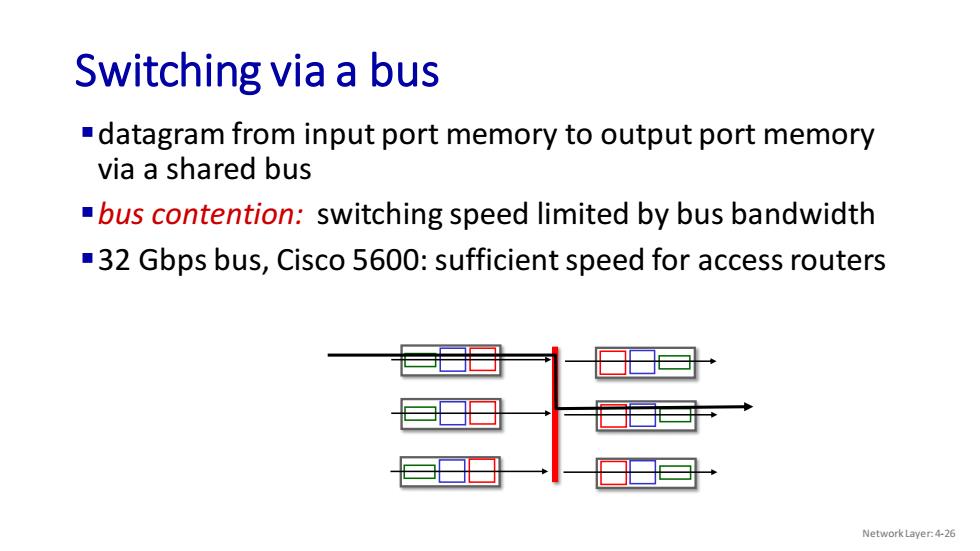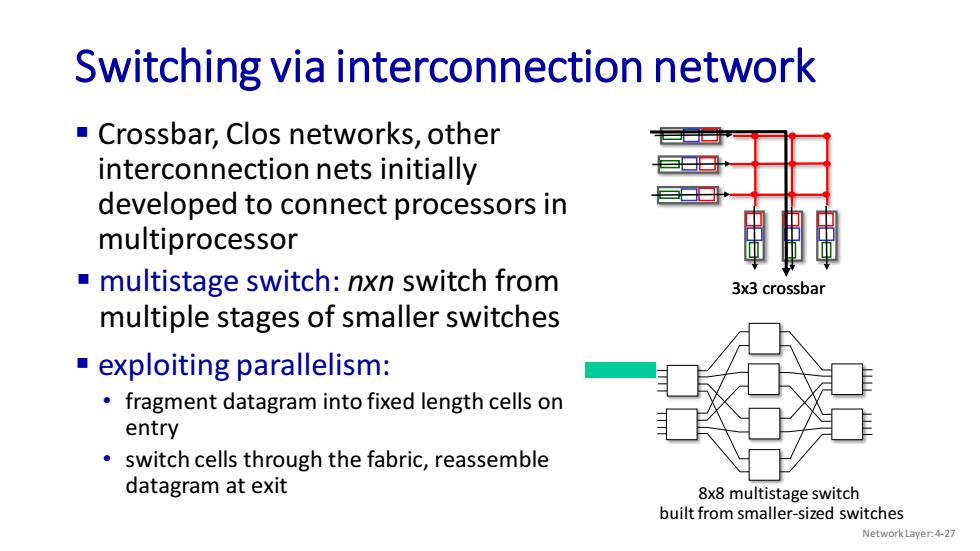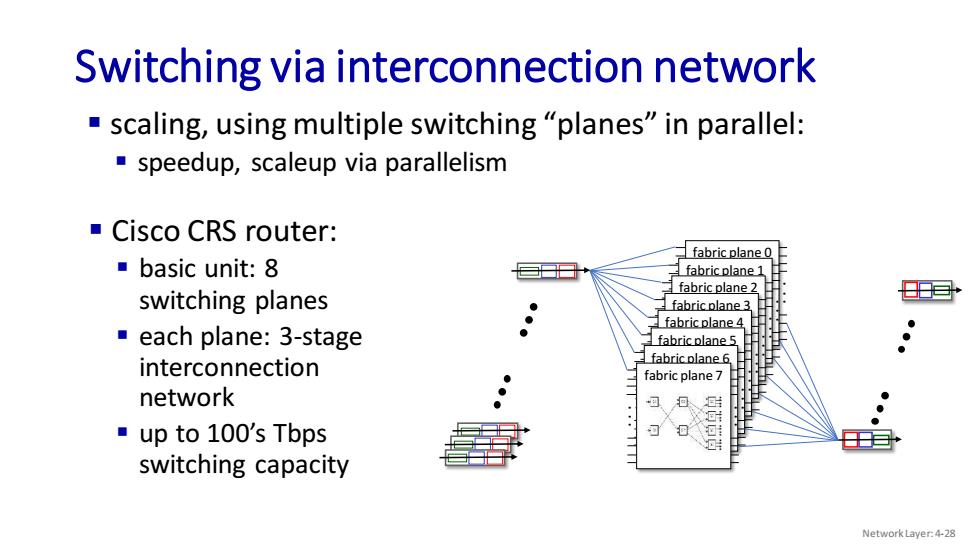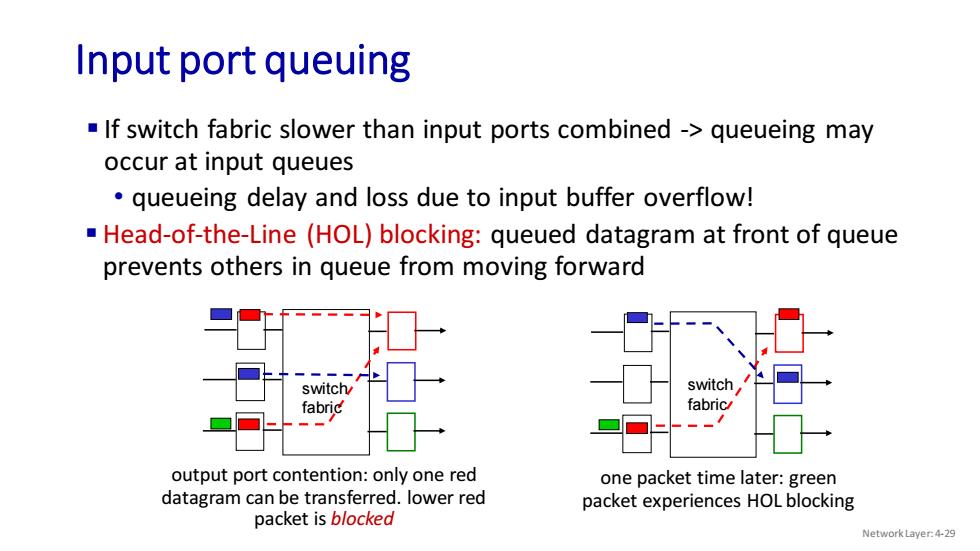
Switching via a bus -datagram from input port memory to output port memory via a shared bus bus contention:switching speed limited by bus bandwidth -32 Gbps bus,Cisco 5600:sufficient speed for access routers Network Layer:4-26
▪datagram from input port memory to output port memory via a shared bus ▪bus contention: switching speed limited by bus bandwidth ▪32 Gbps bus, Cisco 5600: sufficient speed for access routers Switching via a bus Network Layer: 4-26

Switching via interconnection network Crossbar,Clos networks,other interconnection nets initially developed to connect processors in multiprocessor multistage switch:nxn switch from 3x3 crossbar multiple stages of smaller switches exploiting parallelism: fragment datagram into fixed length cells on entry switch cells through the fabric,reassemble datagram at exit 8x8 multistage switch built from smaller-sized switches Network Layer:4-27
▪ Crossbar, Clos networks, other interconnection nets initially developed to connect processors in multiprocessor Switching via interconnection network 8x8 multistage switch built from smaller-sized switches ▪ multistage switch: nxn switch from 3x3 crossbar multiple stages of smaller switches ▪ exploiting parallelism: • fragment datagram into fixed length cells on entry • switch cells through the fabric, reassemble datagram at exit 3x3 crossbar Network Layer: 4-27

Switching via interconnection network scaling,using multiple switching "planes"in parallel: speedup,scaleup via parallelism ■Cisco CRS router: fabric plane 0 ■basic unit:8 fabric plane 1 fabric plane 2 switching planes fabric plane 3 fabric plane 4 ■each plane:3-stage fabric plane 5 interconnection fabric plane 6. fabric plane 7 network ■upto100's Tbps 目 switching capacity Network Layer:4-28
▪ scaling, using multiple switching “planes” in parallel: ▪ speedup, scaleup via parallelism Switching via interconnection network fabric plane 0 . . . . . . fabric plane 1 . . . . . . fabric plane 2 . . . . . . fabric plane 3 . . . . . . fabric plane 4 . . . . . . fabric plane 5 . . . . . . fabric plane 6 . . . . . . fabric plane 7 . . . . . . ▪ Cisco CRS router: ▪ basic unit: 8 switching planes ▪ each plane: 3-stage interconnection network ▪ up to 100’s Tbps switching capacity Network Layer: 4-28

Input port queuing -If switch fabric slower than input ports combined -queueing may occur at input queues queueing delay and loss due to input buffer overflow! Head-of-the-Line (HOL)blocking:queued datagram at front of queue prevents others in queue from moving forward switch/ switch fabric fabric output port contention:only one red one packet time later:green datagram can be transferred.lower red packet experiences HOL blocking packet is blocked Network Layer:4-29
▪ If switch fabric slower than input ports combined -> queueing may occur at input queues • queueing delay and loss due to input buffer overflow! Input port queuing output port contention: only one red datagram can be transferred. lower red packet is blocked switch fabric one packet time later: green packet experiences HOL blocking switch fabric ▪ Head-of-the-Line (HOL) blocking: queued datagram at front of queue prevents others in queue from moving forward Network Layer: 4-29

Output port queuing datagram This is a really importantslide switch buffer link fabric W layer line protocol termination (rate:NR) queueing (send) R Buffering required when datagrams arrive from fabric faster than link Datagrams can be lost transmission rate.Drop policy:which datagrams to drop if no free buffers? due to congestion,lack of buffers Scheduling discipline chooses Priority scheduling -who among queued datagrams for gets best performance, transmission network neutrality Network Layer:4-30
Output port queuing ▪ Buffering required when datagrams arrive from fabric faster than link transmission rate. Drop policy: which datagrams to drop if no free buffers? ▪ Scheduling discipline chooses among queued datagrams for transmission Datagrams can be lost due to congestion, lack of buffers Priority scheduling – who gets best performance, network neutrality This is a really important slide line termination link layer protocol (send) switch fabric (rate: NR) datagram buffer queueing R Network Layer: 4-30